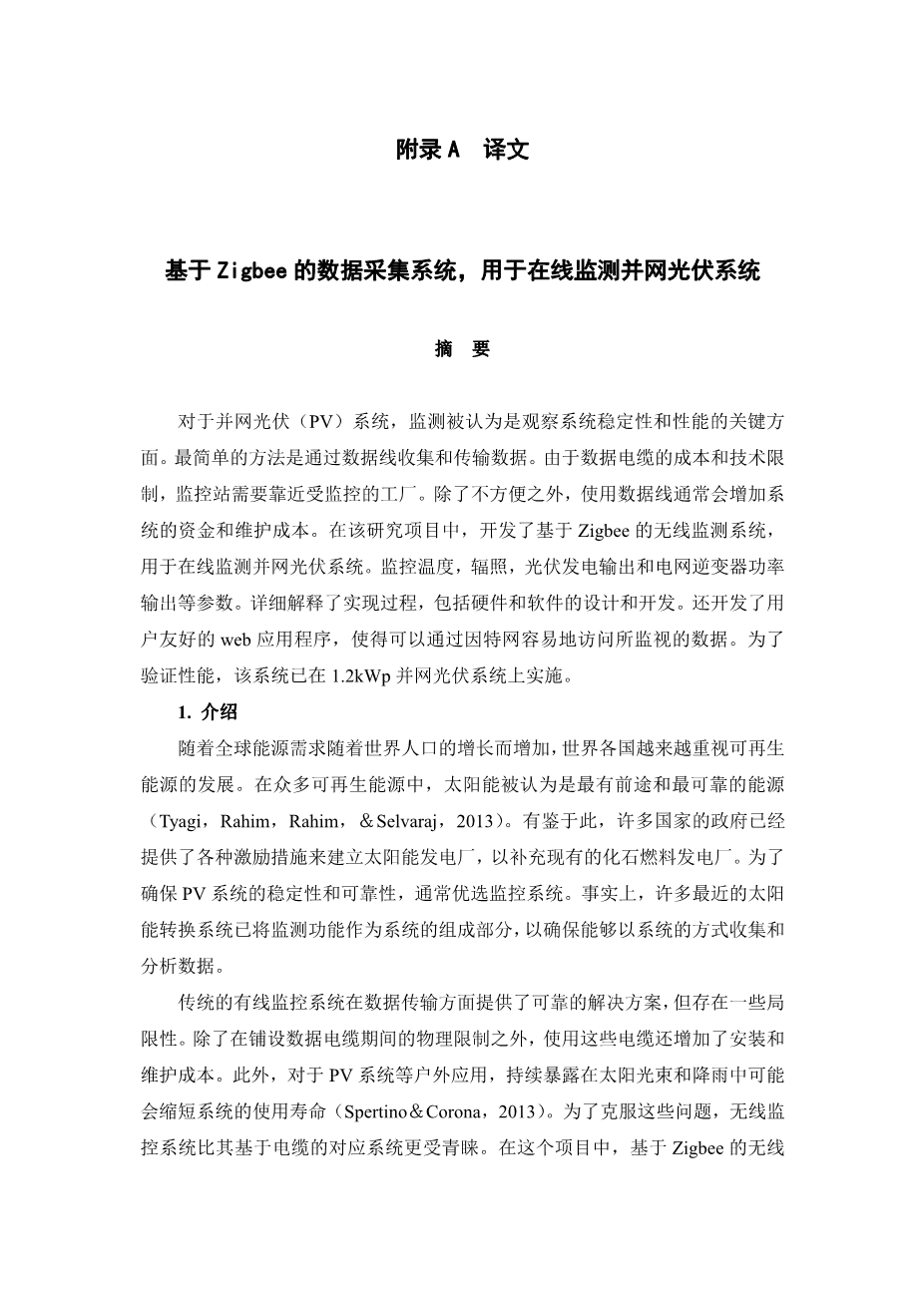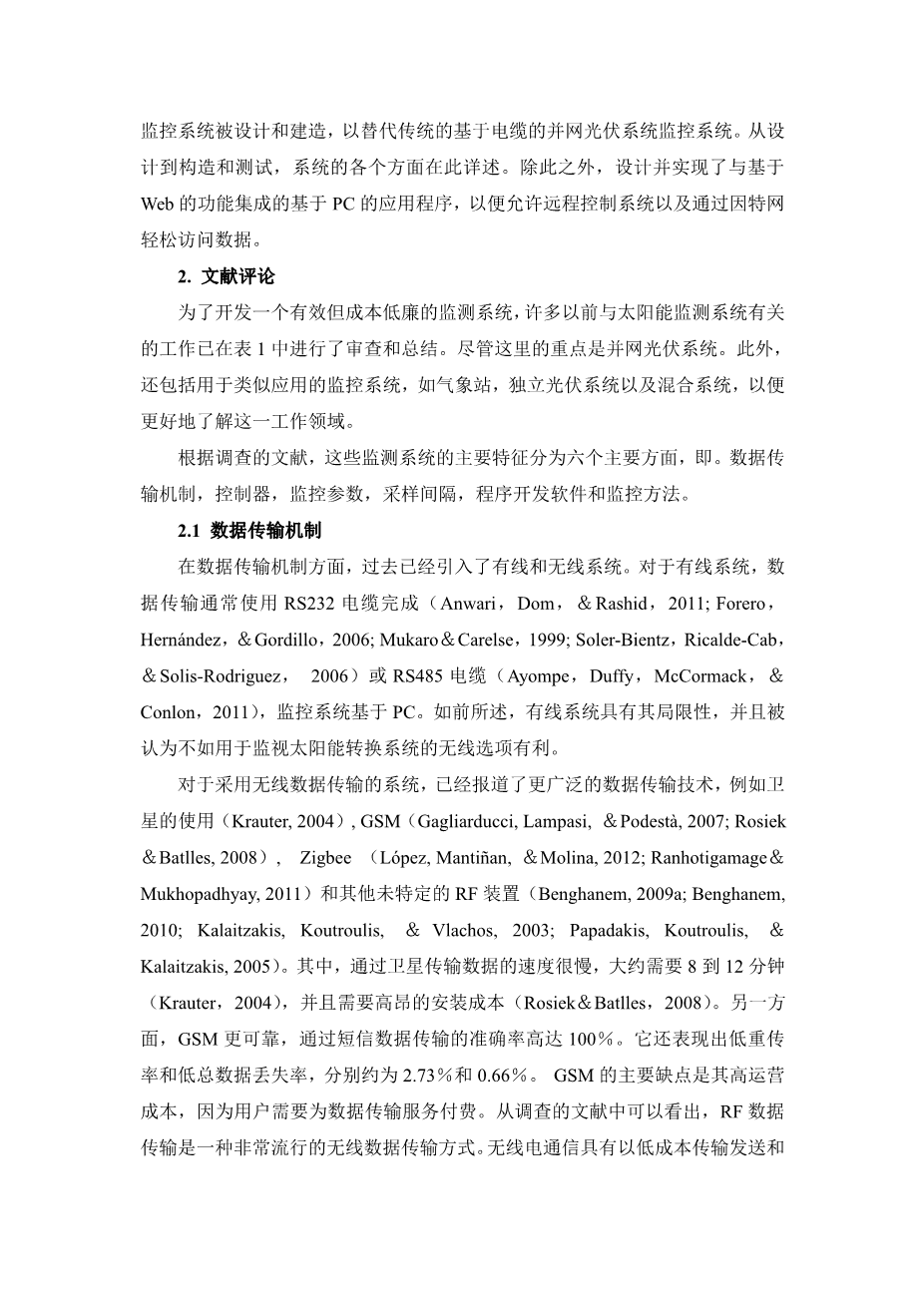基于Zigbee的数据采集系统,用于在线监测并网光伏系统外文翻译资料
2023-08-28 17:10:52
Zigbee-based data acquisition system for online monitoring of grid-connected photovoltaic system
Abstract
For grid-connected photovoltaic (PV) system, monitoring is considered as a crucial aspect for observing the stability and performance of the system. The simplest method is to have the data collected and trans- mitted across data cables. Due to the cost and technical limitations of the data cable, the monitoring sta- tion needs to be located reasonably close to the monitored plant. Apart being inconvenient, the use of data cable often adds capital and maintenance cost to the system. In this research project, a Zigbee-based wireless monitoring system is developed for online monitoring of a grid-connected photovoltaic system. Parameters like temperature, irradiation, PV power output and grid inverter power output are monitored. The implementation process, including design and development of the hardware and software, is explained in detail. A user-friendly web-application is also developed, such that the monitored data is easily accessible via internet. To validate the performance, the system has been implemented on1.25 kWp grid-connected photovoltaic system
1. Introduction
As the global energy demand increases with the growing world population, countries all over the world are putting more and more emphasis on the development of renewable energy. Among the many sources of renewable energy, solar energy is considered the most promising and reliable energy source (Tyagi, Rahim, Rahim, amp; Selvaraj, 2013). In the light of this, governments in many countries have provided various incentives to setup solar energy- based power plants, to complement the existing power plants which are running on fossil fuel. In order to ensure stability and reliability of a PV system, monitoring system is often preferred. As matter of fact, many recent solar energy conversion systems have included monitoring function as an integral part of the systems to ensure data can be collected and analyzed in systematic manner.
Conventional wired monitoring system provides reliable solu- tion in data transmission but suffers from several limitations. Apart from the physical constraints during laying of the data cables, the use of these cables also increases installation and maintenance cost. Besides, for outdoor application such as PV systems, continu- ous exposure to sun beam and rains may reduce the lifespan of the system (Spertino amp; Corona, 2013). To overcome these issues, wire- less monitoring system is favored over its cable-based counterpart. In this project, a Zigbee-based wireless monitoring system is designed and built as a replacement to the conventional cable- based monitoring system for a grid-tied PV system. Various aspects of the system, from design to construction and testing, are detailed here. Besides that, a PC-based application integrated with web- based function is designed and implemented in order to allow remote control of the system as well as easy access of the data over the internet.
2. Literature review
In order to develop an effective yet low cost monitoring system, a number of previous works, which are related to solar energy monitoring system, have been reviewed and summarized in Table 1. Even though the focus here is on grid-connected PV sys- tem, monitoring systems for similar applications such as weather station, stand-alone PV system as well as hybrid systems are also included, to gain a better picture on this area of work.
Based on the surveyed literature, the main characteristics of these monitoring systems are categorized into six main aspects,i.e. the data transfer mechanism, controller, monitored parameters,sampling intervals, program development software and monitor- ing method.
2.1 Data transfer mechanism
In terms of data transfer mechanism, both wired and wireless systems have been introduced in the past. For wired systems, data transmissions are usually done using RS232 cable (Anwari, Dom, amp; Rashid, 2011; Forero, Hernaacute;ndez, amp; Gordillo, 2006; Mukaro amp; Carelse, 1999; Soler-Bientz, Ricalde-Cab, amp; Solis-Rodriguez, 2006) or RS485 cable (Ayompe, Duffy, McCormack, amp; Conlon, 2011), with the monitoring systems being PC-based. As mentioned earlier, wired systems have their limitations, and are considered less favorable than the wireless option for the monitoring of a solar energy conversion system.
For system employing wireless data transmission, a wider vari- ety of data transmission technology has been reported, such as the use of satellite (Krauter, 2004), GSM (Gagliarducci, Lampasi, amp; Podestagrave;, 2007; Rosiek amp; Batlles, 2008), Zigbee (Loacute;pez, Mantintilde;an, amp; Molina, 2012; Ranhotigamage amp; Mukhopadhyay, 2011) and other unspecified RF devices (Benghanem, 2009a; Benghanem,2010; Kalaitzakis, Koutroulis, amp; Vlachos, 2003; Papadakis, Koutroulis, amp; Kalaitzakis, 2005). Among these, data transmission via satellite was reported to be slow, taking around 8 to 12 min (Krauter, 2004) and require high cost of installation (Rosiek amp; Batlles, 2008). GSM on the other hand is more reliable with accu- racy of data transmission via SMS up to 100%. It also exhibit low retransmission rate and low total data loss rate of approximately 2.73% and 0.66%, respectively. The main drawback of GSM is i
剩余内容已隐藏,支付完成后下载完整资料


英语译文共 18 页,剩余内容已隐藏,支付完成后下载完整资料
资料编号:[609466],资料为PDF文档或Word文档,PDF文档可免费转换为Word




